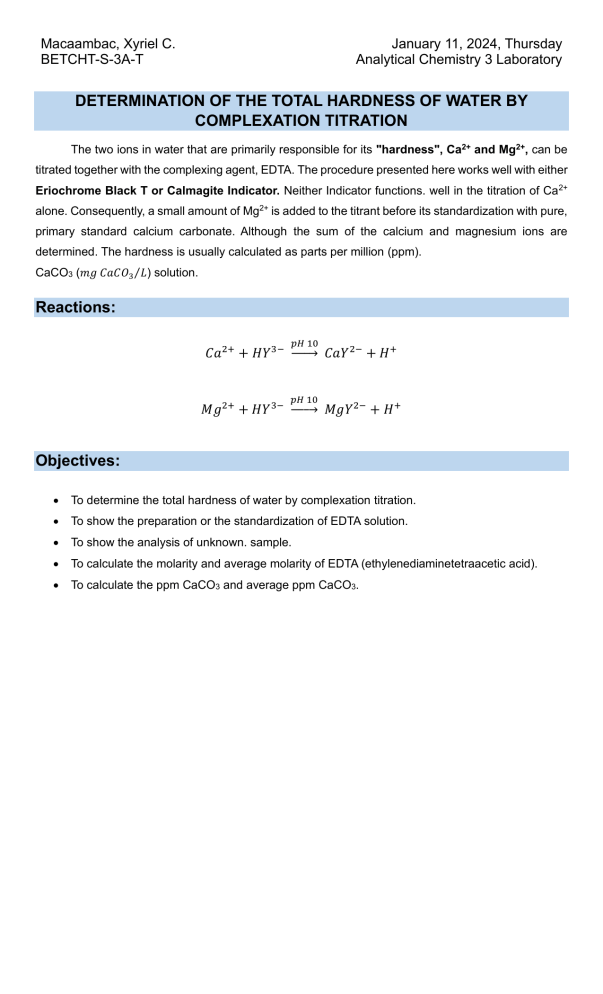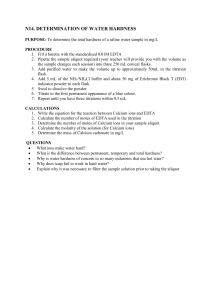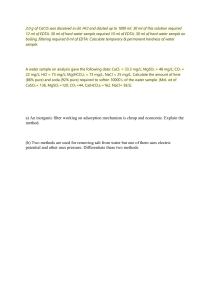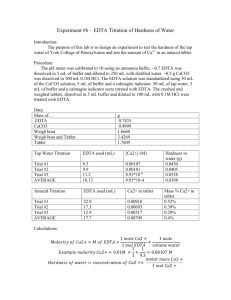
Macaambac, Xyriel C. BETCHT-S-3A-T January 11, 2024, Thursday Analytical Chemistry 3 Laboratory DETERMINATION OF THE TOTAL HARDNESS OF WATER BY COMPLEXATION TITRATION The two ions in water that are primarily responsible for its "hardness", Ca2+ and Mg2+, can be titrated together with the complexing agent, EDTA. The procedure presented here works well with either Eriochrome Black T or Calmagite Indicator. Neither Indicator functions. well in the titration of Ca2+ alone. Consequently, a small amount of Mg2+ is added to the titrant before its standardization with pure, primary standard calcium carbonate. Although the sum of the calcium and magnesium ions are determined. The hardness is usually calculated as parts per million (ppm). CaCO3 (𝑚𝑔 𝐶𝑎𝐶𝑂3 ⁄𝐿) solution. Reactions: 𝑝𝐻 10 𝐶𝑎2+ + 𝐻𝑌 3− → 𝑝𝐻 10 𝑀𝑔2+ + 𝐻𝑌 3− → 𝐶𝑎𝑌 2− + 𝐻+ 𝑀𝑔𝑌 2− + 𝐻+ Objectives: • To determine the total hardness of water by complexation titration. • To show the preparation or the standardization of EDTA solution. • To show the analysis of unknown. sample. • To calculate the molarity and average molarity of EDTA (ethylenediaminetetraacetic acid). • To calculate the ppm CaCO3 and average ppm CaCO3. Materials /Reagents / Equipment Needed: Reagents: Glassware / Equipment Needed: 1. 1.0 g of Na2H2Y.2H2O • Storage Bottle 2. 450 ml of distilled water • Desiccator 3. 0.5 g of NaOH • Conical Flask 4. 0.05 g of MgCl2.6H2O • 500 ml volumetric flask 5. 2 g of primary-standard-grade CaCO3 • Pipette (500 mL) 6. 5 ml of concentrated HCl solution • Analytical Balance 7. NH3, NH4Cl • Burette 8. Methanol • Dropper • Funnel Procedure: Job 1: Preparation of 500ml 0.005 M EDTA solution. • Dissolve about 1.0g of Na2H2Y.2H2O (disodium dihydrate of EDTA) in 450 ml of distilled water containing 0.5 g of NaOH and 0.05 g of MgCl2.6H2O. Dilute to 500 ml and mix well. Transfer to a labeled storage bottle. Job 2: Standardization of 0.005 M EDTA solution. • Dry 2 g of primary-standard-grade CaCO3 at 118℃ for 1h and cool in a desiccator. • Weigh accurately 0.20 to 0.25 g of the dry CaCO3 and transfer to a 250-ml conical flask. • Add 50 mL distilled H2O after dissolution is complete, add 3 mL concentrated HCI. Boil for 5 min to remove carbon dioxide. Transfer the cooled solution and rinsing to a 500 mL volumetric flask and dilute to the mark with distilled water. Mix well the color of the prepared solution is colorless. • Pipette three 25 mL portions of the calcium solution into 250 mL conical flasks. Add 10 ml of ammonia buffer to each flask. • To the first flask, add 5 drops of Eriochrome Black T indicator (Wine-red color) and titrate with the 0.005 M EDTA to the first appearance of a clear blue color. Ordinarily, the initial wine-red color turns slowly to purple and then sharply to blue. Repeat the titration with the remaining two solutions. • Calculate the average molarity of the EDTA. Job 3: Analysis of the Unknown. • Pipette three 50 mL portions of the water sample into 250 mL conical flasks and add 10 ml of the ammonia buffer to each sample. • Titrate as in step 5 of the standardization procedure. • Calculate the total hardness as ppm CaCO3. Data Sheet: Job 2: Calcium Carbonate Solution Trial Volume of CaCO3 (mL) Weight of CaCO3 (g) Volume of EDTA (mL) M EDTA 1 25.00 mL 0.2086 g 42.00 mL 0.000496 M 2 25.00 mL 0.2086 g 41.40 mL 0.000503 M 3 25.00 mL 0.2086 g 41.30 mL 0.000504 M Maverage 0.000501 M Trial 1: 𝑚𝑚𝑜𝑙 𝐶𝑎𝐶𝑂3 = 𝑚𝑚𝑜𝑙 𝐸𝐷𝑇𝐴 𝑤𝑒𝑖𝑔ℎ𝑡 𝐶𝑎𝐶𝑂3 = 𝑉𝑜𝑙𝑢𝑚𝑒𝐸𝐷𝑇𝐴 (𝑀𝑜𝑙𝑎𝑟𝑖𝑡𝑦𝐸𝐷𝑇𝐴 ) 𝑀𝑜𝑙𝑒𝑐𝑢𝑙𝑎𝑟 𝑊𝑒𝑖𝑔ℎ𝑡 𝐶𝑎𝐶𝑂3 𝑚𝑚𝑜𝑙 𝐶𝑎𝐶𝑂3 𝑖𝑛 250 𝑚𝐿 = 0.2086 𝑚𝑔 = 𝟎. 𝟎𝟎𝟐𝟎𝟖𝟒18884 𝑚𝑚𝑜𝑙 100.0869 𝑚𝑔⁄𝑚𝑚𝑜𝑙 𝑚𝑚𝑜𝑙 𝐶𝑎𝐶𝑂3 𝑖𝑛 25 𝑚𝐿 𝑎𝑙𝑖𝑞𝑢𝑜𝑡 = 0.002084 𝑚𝑚𝑜𝑙 × 250 𝑚𝐿 = 𝟎. 𝟎𝟐𝟎𝟖𝟒 𝒎𝒎𝒐𝒍 25 𝑚𝐿 𝑚𝑚𝑜𝑙 𝐶𝑎𝐶𝑂3 = 𝑉𝐸𝐷𝑇𝐴 (𝑀𝐸𝐷𝑇𝐴 ) 0.02084 𝑚𝑚𝑜𝑙 = 42.00 𝑚𝐿 (𝑀𝐸𝐷𝑇𝐴 ) 𝑀𝐸𝐷𝑇𝐴 = 0.02084 𝑚𝑚𝑜𝑙 42.00 𝑚𝑙 𝑴𝑬𝑫𝑻𝑨 = 𝟎. 𝟎𝟎𝟎𝟒𝟗𝟔 𝑴 Trial 2: 𝑚𝑚𝑜𝑙 𝐶𝑎𝐶𝑂3 = 𝑚𝑚𝑜𝑙 𝐸𝐷𝑇𝐴 𝑤𝑒𝑖𝑔ℎ𝑡 𝐶𝑎𝐶𝑂3 = 𝑉𝑜𝑙𝑢𝑚𝑒𝐸𝐷𝑇𝐴 (𝑀𝑜𝑙𝑎𝑟𝑖𝑡𝑦𝐸𝐷𝑇𝐴 ) 𝑀𝑜𝑙𝑒𝑐𝑢𝑙𝑎𝑟 𝑊𝑒𝑖𝑔ℎ𝑡 𝐶𝑎𝐶𝑂3 𝑚𝑚𝑜𝑙 𝐶𝑎𝐶𝑂3 𝑖𝑛 250 𝑚𝐿 = 0.2086 𝑚𝑔 = 𝟎. 𝟎𝟎𝟐𝟎𝟖𝟒18884 𝑚𝑚𝑜𝑙 100.0869 𝑚𝑔⁄𝑚𝑚𝑜𝑙 𝑚𝑚𝑜𝑙 𝐶𝑎𝐶𝑂3 𝑖𝑛 25 𝑚𝐿 𝑎𝑙𝑖𝑞𝑢𝑜𝑡 = 0.002084 𝑚𝑚𝑜𝑙 × 250 𝑚𝐿 = 𝟎. 𝟎𝟐𝟎𝟖𝟒 𝒎𝒎𝒐𝒍 25 𝑚𝐿 𝑚𝑚𝑜𝑙 𝐶𝑎𝐶𝑂3 = 𝑉𝐸𝐷𝑇𝐴 (𝑀𝐸𝐷𝑇𝐴 ) 0.02084 𝑚𝑚𝑜𝑙 = 41.40 𝑚𝐿 (𝑀𝐸𝐷𝑇𝐴 ) 𝑀𝐸𝐷𝑇𝐴 = 0.02084 𝑚𝑚𝑜𝑙 41.40 𝑚𝑙 𝑴𝑬𝑫𝑻𝑨 = 𝟎. 𝟎𝟎𝟎𝟓𝟎𝟑 𝑴 Trial 3: 𝑚𝑚𝑜𝑙 𝐶𝑎𝐶𝑂3 = 𝑚𝑚𝑜𝑙 𝐸𝐷𝑇𝐴 𝑤𝑒𝑖𝑔ℎ𝑡 𝐶𝑎𝐶𝑂3 = 𝑉𝑜𝑙𝑢𝑚𝑒𝐸𝐷𝑇𝐴 (𝑀𝑜𝑙𝑎𝑟𝑖𝑡𝑦𝐸𝐷𝑇𝐴 ) 𝑀𝑜𝑙𝑒𝑐𝑢𝑙𝑎𝑟 𝑊𝑒𝑖𝑔ℎ𝑡 𝐶𝑎𝐶𝑂3 𝑚𝑚𝑜𝑙 𝐶𝑎𝐶𝑂3 𝑖𝑛 250 𝑚𝐿 = 0.2086 𝑚𝑔 = 𝟎. 𝟎𝟎𝟐𝟎𝟖𝟒18884 𝑚𝑚𝑜𝑙 100.0869 𝑚𝑔⁄𝑚𝑚𝑜𝑙 𝑚𝑚𝑜𝑙 𝐶𝑎𝐶𝑂3 𝑖𝑛 25 𝑚𝐿 𝑎𝑙𝑖𝑞𝑢𝑜𝑡 = 0.002084 𝑚𝑚𝑜𝑙 × 250 𝑚𝐿 = 𝟎. 𝟎𝟐𝟎𝟖𝟒 𝒎𝒎𝒐𝒍 25 𝑚𝐿 𝑚𝑚𝑜𝑙 𝐶𝑎𝐶𝑂3 = 𝑉𝐸𝐷𝑇𝐴 (𝑀𝐸𝐷𝑇𝐴 ) 0.02084 𝑚𝑚𝑜𝑙 = 41.30 𝑚𝐿 (𝑀𝐸𝐷𝑇𝐴 ) 𝑀𝐸𝐷𝑇𝐴 = 0.02084 𝑚𝑚𝑜𝑙 41.30 𝑚𝑙 𝑴𝑬𝑫𝑻𝑨 = 𝟎. 𝟎𝟎𝟎𝟓𝟎𝟒 𝑴 𝑴𝒂𝒗𝒆𝒓𝒂𝒈𝒆 = 𝟎. 𝟎𝟎𝟎𝟒𝟗𝟔 𝑴 + 𝟎. 𝟎𝟎𝟎𝟓𝟎𝟑 𝑴 + 𝟎. 𝟎𝟎𝟎𝟓𝟎𝟒 𝑴 𝟑 𝑴𝒂𝒗𝒆𝒓𝒂𝒈𝒆 = 𝟎. 𝟎𝟎𝟎𝟓𝟎𝟏 𝑴 Job 3: Tap Water Sample Solution Trial Volume of H2O (mL) Volume of EDTA (mL) ppm CaCO3 1 50.00 mL 19.00 mL 19.05 ppm 2 50.00 mL 20.90 mL 20.96 ppm 3 50.00 mL 21.00 mL 21.06 ppm Ave. ppm CaCO3 20.36 ppm Trial 1: 𝑚𝑚𝑜𝑙 𝐶𝑎𝐶𝑂3 = 𝑚𝑚𝑜𝑙 𝐸𝐷𝑇𝐴 𝑚𝑚𝑜𝑙 𝐸𝐷𝑇𝐴 ) 𝑚𝐿 𝐸𝐷𝑇𝐴 1 𝑚𝑚𝑜𝑙 𝐶𝑎𝐶𝑂3 = 0.009519 𝑚𝑚𝑜𝑙 𝐸𝐷𝑇𝐴 × 1 𝑚𝑚𝑜𝑙 𝐸𝐷𝑇𝐴 = 0.009519 𝑚𝑚𝑜𝑙 𝐶𝑎𝐶𝑂3 = 19.00 𝑚𝐿 𝐸𝐷𝑇𝐴 (0.000501 𝑀𝑔 𝐶𝑎𝐶𝑂3 = 𝑚𝑚𝑜𝑙 𝐶𝑎𝐶𝑂3 × 𝑀𝑜𝑙𝑒𝑐𝑢𝑙𝑎𝑟 𝑊𝑒𝑖𝑔ℎ𝑡 𝐶𝑎𝐶𝑂3 𝑚𝑔 𝐶𝑎𝐶𝑂3 = 0.009519 𝑚𝑚𝑜𝑙 𝐶𝑎𝐶𝑂3 (100.0869 ) 𝑚𝑚𝑜𝑙 𝐶𝑎𝐶𝑂3 = 0.9527 𝑚𝑔 𝐶𝑎𝐶𝑂3 𝑝𝑝𝑚 𝐶𝑎𝐶𝑂3 = 𝑀𝑔 𝐶𝑎𝐶𝑂3 ⁄ 𝑉𝑜𝑙𝑢𝑚𝑒 𝑜𝑓 𝑊𝑎𝑡𝑒𝑟 𝑆𝑎𝑚𝑝𝑙𝑒 𝑖𝑛 𝐿𝑖𝑡𝑒𝑟𝑠. 0.9527 𝑚𝑔 = 0.05 𝐿 = 19.054 𝑝𝑝𝑚 ≈ 19.05 𝑝𝑝𝑚 𝒑𝒑𝒎 𝑪𝒂𝑪𝑶𝟑 = 𝟏𝟗. 𝟎𝟓 𝒑𝒑𝒎 Trial 2: 𝑚𝑚𝑜𝑙 𝐶𝑎𝐶𝑂3 = 𝑚𝑚𝑜𝑙 𝐸𝐷𝑇𝐴 𝑚𝑚𝑜𝑙 𝐸𝐷𝑇𝐴 ) 𝑚𝐿 𝐸𝐷𝑇𝐴 1 𝑚𝑚𝑜𝑙 𝐶𝑎𝐶𝑂3 = 0.010470 𝑚𝑚𝑜𝑙 𝐸𝐷𝑇𝐴 × 1 𝑚𝑚𝑜𝑙 𝐸𝐷𝑇𝐴 = 0.010470 𝑚𝑚𝑜𝑙 𝐶𝑎𝐶𝑂3 = 20.90 𝑚𝐿 𝐸𝐷𝑇𝐴 (0.000501 𝑀𝑔 𝐶𝑎𝐶𝑂3 = 𝑚𝑚𝑜𝑙 𝐶𝑎𝐶𝑂3 × 𝑀𝑜𝑙𝑒𝑐𝑢𝑙𝑎𝑟 𝑊𝑒𝑖𝑔ℎ𝑡 𝐶𝑎𝐶𝑂3 𝑚𝑔 𝐶𝑎𝐶𝑂3 = 0.010470 𝑚𝑚𝑜𝑙 𝐶𝑎𝐶𝑂3 (100.0869 ) 𝑚𝑚𝑜𝑙 𝐶𝑎𝐶𝑂3 = 1.0479 𝑚𝑔 𝐶𝑎𝐶𝑂3 𝑝𝑝𝑚 𝐶𝑎𝐶𝑂3 = 𝑀𝑔 𝐶𝑎𝐶𝑂3 ⁄ 𝑉𝑜𝑙𝑢𝑚𝑒 𝑜𝑓 𝑊𝑎𝑡𝑒𝑟 𝑆𝑎𝑚𝑝𝑙𝑒 𝑖𝑛 𝐿𝑖𝑡𝑒𝑟𝑠. 1.0479 𝑚𝑔 = 0.05 𝐿 = 20.96 𝑝𝑝𝑚 𝒑𝒑𝒎 𝑪𝒂𝑪𝑶𝟑 = 𝟐𝟎. 𝟗𝟔 𝒑𝒑𝒎 Trial 3: 𝑚𝑚𝑜𝑙 𝐶𝑎𝐶𝑂3 = 𝑚𝑚𝑜𝑙 𝐸𝐷𝑇𝐴 𝑚𝑚𝑜𝑙 𝐸𝐷𝑇𝐴 ) 𝑚𝐿 𝐸𝐷𝑇𝐴 1 𝑚𝑚𝑜𝑙 𝐶𝑎𝐶𝑂3 = 0.010521 𝑚𝑚𝑜𝑙 𝐸𝐷𝑇𝐴 × 1 𝑚𝑚𝑜𝑙 𝐸𝐷𝑇𝐴 = 0.010521 𝑚𝑚𝑜𝑙 𝐶𝑎𝐶𝑂3 = 21.00 𝑚𝐿 𝐸𝐷𝑇𝐴 (0.000501 𝑀𝑔 𝐶𝑎𝐶𝑂3 = 𝑚𝑚𝑜𝑙 𝐶𝑎𝐶𝑂3 × 𝑀𝑜𝑙𝑒𝑐𝑢𝑙𝑎𝑟 𝑊𝑒𝑖𝑔ℎ𝑡 𝐶𝑎𝐶𝑂3 𝑚𝑔 𝐶𝑎𝐶𝑂3 = 0.010521 𝑚𝑚𝑜𝑙 𝐶𝑎𝐶𝑂3 (100.0869 ) 𝑚𝑚𝑜𝑙 𝐶𝑎𝐶𝑂3 = 1.0530 𝑚𝑔 𝐶𝑎𝐶𝑂3 𝑝𝑝𝑚 𝐶𝑎𝐶𝑂3 = 𝑀𝑔 𝐶𝑎𝐶𝑂3 ⁄ 𝑉𝑜𝑙𝑢𝑚𝑒 𝑜𝑓 𝑊𝑎𝑡𝑒𝑟 𝑆𝑎𝑚𝑝𝑙𝑒 𝑖𝑛 𝐿𝑖𝑡𝑒𝑟𝑠. 1.0530 𝑚𝑔 = 0.05 𝐿 = 21.06 𝑝𝑝𝑚 𝒑𝒑𝒎 𝑪𝒂𝑪𝑶𝟑 = 𝟐𝟏. 𝟎𝟔 𝒑𝒑𝒎 𝑨𝒗𝒆𝒓𝒂𝒈𝒆𝒑𝒑𝒎 𝑪𝒂𝑪𝑶𝟑 = 𝟏𝟗. 𝟎𝟓 + 𝟐𝟎. 𝟗𝟔 + 𝟐𝟏. 𝟎𝟔 𝟑 𝑨𝒗𝒆𝒓𝒂𝒈𝒆𝒑𝒑𝒎 𝑪𝒂𝑪𝑶𝟑 = 𝟐𝟎. 𝟑𝟓𝟔 ≈ 𝟐𝟎. 𝟑𝟔 𝒑𝒑𝒎 Guide Questions: 1. Which form of EDTA is used in any analytical experiment? Why? a. Complexometric titrations are used mainly to determine metal ions by use of complexforming reactions. Although many complexing agents (cyanide, thiocyanate, fluoride, 1,2diaminoethane, etc.) can be used for this purpose, in practice the titrants are almost always compounds having the iminodiacetic acid functional groups. The most widely applied are ethylenediaminetetraacetic acid, H4Y and the dihydrate of the sodium salt, Na2H2Y ⋅ 2H2O (better soluble in water). 2. Why is the solution containing the metal ion buffered before titrating with EDTA? a. The reason for buffering the solution before titrating with EDTA in complexometric titrations is to maintain a constant pH throughout the titration process. EDTA is a chelating agent that forms complexes with metal ions. The formation of these complexes is pHdependent, and the pH value affects the stability and formation of the complexes. b. By buffering the solution, the pH can be controlled and maintained at a specific value. This ensures that the reaction between the metal ion and EDTA proceeds smoothly and goes to completion. Additionally, maintaining a constant pH helps in achieving accurate and reproducible results. 3. What is water hardness? How would you express total hardness in water? a. Hard water is water containing high amounts of mineral ions. The most common ions found in hard water are the metal cations calcium (Ca 2+) and magnesium (Mg2+), though iron, aluminum, and manganese may also be found in certain areas. These metals are water soluble, meaning they will dissolve in water. The relatively high concentrations of these ions can saturate the solution and consequently cause the equilibrium of these solutes to shift to the left, towards reactants. In other words, the ions can precipitate out of the solution. This displacement of minerals from the solution is responsible for the calcination often seen on water faucets, which is a precipitation of calcium or magnesium carbonate. Hard water may also react with other substances in the solution, such as soap, and form a precipitate called "scum." b. Total hardness in water is typically expressed in terms of milligrams per liter (mg/L) or parts per million (ppm) of calcium carbonate CaCO3 equivalent. 4. Explain the action of EBT as an indicator in an EDTA titration. In an EDTA titration, EBT (Eriochrome Black T) is commonly used as an indicator. EBT is blue in a buffered solution at pH 10. When calcium ions (Ca 2+) are added to the solution, EBT turns red. During the titration, a solution containing the analyte (the substance being analyzed) is titrated with a standard solution of EDTA (ethylenediaminetetraacetic acid). EDTA forms stable complexes with metal ions, including calcium. In the early stages of the titration, the Ca2+ - EBT complex does not dissociate significantly because of the large excess of untreated Ca2+ ions in solution. As EDTA is gradually added, it chelates the metal ions bound to the indicator, leaving the free EBT molecules. When sufficient EDTA is added, the characteristic blue endpoint is reached, indicating the completion of the titration. The color change from red to blue is used to detect the endpoint of the titration. This color change occurs when all the calcium ions have been complexed by EDTA, and the free EBT molecules are present in the solution. 5. Explain the need of adding MgCl2.6H2O to EDTA solution before standardization. The addition of MgCl2·6H2O to an EDTA solution before standardization is done to ensure that any existing metal ions in the EDTA solution are complexed and removed. When EDTA (ethylenediaminetetraacetic acid) is prepared, it may contain traces of metal impurities. These metal impurities can interfere with the accurate determination of the concentration of the EDTA solution during standardization. By adding MgCl2·6H2O to the EDTA solution, the magnesium ions (Mg2+) form a complex with the EDTA, known as Mg-EDTA complex. This complexation reaction helps to remove any metal impurities present in the EDTA solution by forming stable complexes with them. Adding MgCl2·6H2O to the EDTA solution before standardization ensures that any metal impurities are effectively removed, allowing for accurate determination of the concentration of the EDTA solution. Borrower’s Slip TECHNOLOGICAL UNIVERSITY OF THE PHILIPPINES TAGUIG CITY The technological University of the Philippines shall be the premiere state university and the model of excellence in technology education in the country in a knowledge-based economy of the 21st century. LABORATORY/WORKSHOP BORROWER’S SLIP Borrower’s Name: Macaambac, Xyriel C. Year/Section: BETCHT-S-3A-T Date Received: Group No. Date Returned: GROUP MEMBERS NO. NAME 1 Macaambac, Xyriel C. 2 Rellores, Sheryl C. 3 Rivera, Marjorie L. SIGNATURE TOOLS/MATERIALS ITEM NO. QUANTITY 1 1 UNIT DESCRIPTION Wash Bottle Key Notes ✓ Weigh by Difference ✓ Schematic Diagram for Procedures ✓ Sample Calculation for Given value for Table 1 and 2 REMARKS ✓ Advanced Answer the Guide Questions ✓ How to read properly a pipette ✓ Difference between Pipette to Volumetric Pipette ✓ Borrowed Slip for Glassware’s and other materials to be borrowed in advance. References • Solution Preparation and Calculation • Titration of Total Hardness of Water Lab Experiment • How to Dilute a Solution • Weigh By Difference of a Solid • Water Hardness (EDTA) Titration Calculations Example • Water Hardness and pH • https://www.sciencedirect.com/topics/chemistry/complexometric-titration •






